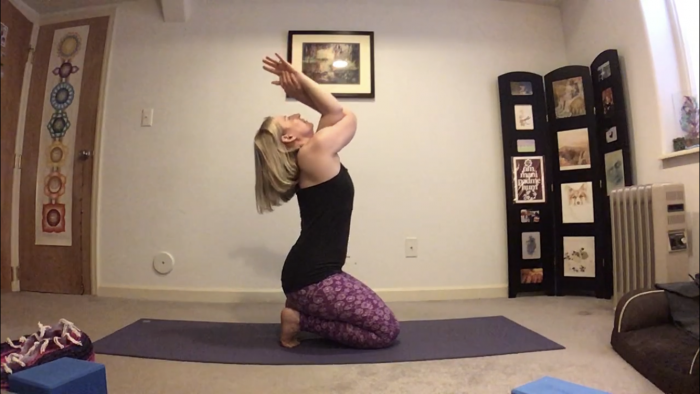Yoga studios have been closing at an alarming rate.
It is becoming economically unfeasible to yoga studios to stay open due to new pandemic-enforced attendance restrictions. Even if there were no restrictions, attendance would still be low: due to students and teachers feeling unsafe practicing together in an enclosed space.
No one knows how long these restrictions will be in place—so, more and more people are going online for their yoga practice.
Online yoga is not new; recorded online yoga has been a thing for many years. Yoga sites, with memberships, provide access to hundreds of recorded classes—and there are hundreds of free classes on YouTube.
However, recorded classes have some drawbacks: even though these websites have hundreds of yoga classes to choose from—with a variety of different styles and time lengths—it gets boring.
Many yogis find they end up doing the same two to three classes over and over. If you are paying for a membership to access thousands of classes, you do not feel like you are getting value for your money. Recorded online yoga classes are no different than owning a yoga DVD.
Another problem with recorded yoga is the commitment issue.
When you are practicing from home along with a recording, it is easy to push pause on your device because you forgot to take the chicken out of the freezer for dinner. It is too easy to answer the phone when someone calls in the middle of your vinyasa.
The greatest thing about practicing yoga at a brick-and-mortar studio is that you know, for the next 60 minutes, you will not be disturbed. Everything in your life that pulls you this way and that is outside the yoga room. No phone, boss, to-do lists, family—it is just you and your mat. And even if you do remember you forgot to take the chicken out of the freezer, there’s nothing you can do about it for the next 60 minutes anyway—so you let it go.
There are many problems with committing to a home practice: at home, it’s easy to say, “I need to get this done really quick and then I’ll do yoga,” but five “really quick” things later, you realize it’s six p.m. and time to get dinner ready—the day is gone.
At a brick-and-mortar yoga studio, you sign up for the class ahead of time—you are committed. And if you don’t make it to the studio in time, you miss your chance to practice altogether, which adds more weight to your commitment.
Knowing you are committed to a time and place makes all the difference in a yoga practice.
The final problem when doing recorded classes is: there is no human contact. Part of why we go to a studio is to practice as a community; it adds an undeniable energy to the class. Live studio teachers make every class unique by creating class themes, offering encouragement, and sometimes messing up the sequence or making the class laugh.
In a recorded class, everything is polished and general—you do not improvise in a recorded class; instead you stay on task and maintain a sense of professionalism.
In person, at a studio, you get to experience the teacher’s personality.
A good alternative to recorded yoga classes are livestream ones, which break through all the downfalls of online yoga.
Livestream yoga is not recorded: there is a teacher instructing the class live, which creates variety—even if that teacher taught the same flow for a couple weeks, no two classes would be the same.
Livestream yoga classes remove most of the commitment issues that result from recorded ones: you must arrive on your mat at a precise time in order to attend, and if the phone rings you can answer it but you will miss some of the class—you cannot pause, or even rewind to what you missed. It’s as close as you can get to the feeling of walking into a studio and practicing as a community, without leaving your house.
The teacher usually starts livestreaming 15 minutes before the class starts, creating space for the teacher to touch base with the attending students and allows for students to talk with each other. The same opportunity is available after class, just like in brick-and-mortar yoga studios, when a student hangs out after class to chat with the teacher and other students. This is where the feeling of community is generated; livestream yoga creates the space for yogis to touch base with each other.
For those of you who like to be in the back of the class and remain unseen, livestreaming has a special feature for you: you can turn off your video so no one can see you—allowing you to stay in your pajamas!
Online streaming makes it difficult for the teacher to provide music for the class—which brings me to what I believe is a bonus of online streaming: you can choose your own music.
Most teachers will mute everyone at the start of class, keeping random student sounds from disrupting the class, this means you can play whatever music you like; some people like background spa-type music; or more upbeat music; some people like music with singing; and some don’t like music at all—with livestream yoga, everyone can listen to what they want and still practice together.
More good news: if you are someone who loves a nice, long, yummy Savasana or Corpse Pose, livestreaming is for you. In a studio, you rarely get a long Savasana; it ends after two minutes or students leave and move around you noisily. However, in a livestream yoga class, when it is time for Savasana, you can leave the class and stay laying on your mat as long as you want.
It must also be mentioned that livestream yoga has made private yoga sessions more accessible and affordable. When the pandemic shut everything down, many yoga teachers moved their private yoga clients to remote sessions, via Zoom or Facetime—most of my clients report a seamless transition, and that they are still receiving the full benefits of a private class.
Livestream yoga is a portal to a whole new world of yoga: you can practice with studios in other states and even other countries. And you can easily try different styles of yoga that may not be available in your area.
Livestream yoga is enjoyable and creates a sense of community—it is the future of yoga; with yoga studios closing left and right, it may be the only thing left until the yoga industry can bounce back from the financial burdens of the pandemic.
Give livestream yoga classes a try.
To find online livestream yoga, check with your local studios to see if they are offering online classes. You can also access livestream classes through MindBodyOnline, Vagaro, and ClassPass.
~









Read 0 comments and reply